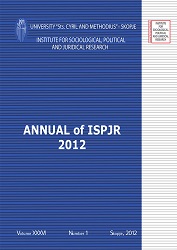CONTINUITY OF THE OTTOMAN MUSIC IN THE MUSIC CULTURE OF THE TURKISH COMMUNITY IN MACEDONIA TODAY
CONTINUITY OF THE OTTOMAN MUSIC IN\ THE MUSIC CULTURE OF THE TURKISH COMMUNITY IN MACEDONIA TODAY
Author(s): Aida IslamSubject(s): Music, Social psychology and group interaction, Identity of Collectives
Published by: Институт за социолошки и политичко-правни истражувања
Keywords: musical culture; Ottoman music; continuity of the tradition; musical instruments
Summary/Abstract: Several centuries of the presence of the Ottoman culture in the region of Macedonia reflects on the musical culture of the local population especially on the members of the Turkish community. The continuity of the Ottoman music is evident in: musical repertoire, music instruments and the traditional ceremonies. However, as a result of the characteristics that constitute modern day living, musical tradition of the Turkish population is experiencing certain transformations in the past few decades. Therefore, in this text we are referring to the level of the presence of continuity and the changes that occurred in all the spheres of the Turkish musical culture today. The modifications are especially present in the secular (urban and rural) music and they are manifested through: reduced use of the traditional instruments, use of electronic musical instruments (synthesizer), modifications in the tonal structure of the musical works, narrowing of the musical repertoire, integration of imported repertoire and changes of the texts of the traditional songs. The continuity of tradition is more consistent in the spiritual music in the ritual services in the mosques, while in the dervish tradition, narrowing of the musical repertoire and integrating of the secular melodies in the spiritual ceremonies is evident. The occurred modifications in the musical culture of the Turkish population in Macedonia are the result of the mass migration of the population in the 50-60s, reducing in that way the musical potential, and also the reflections of the globalization that is increasingly entering even in the most subtle segments of the modern day living.
Journal: Annual of the Institute for Sociological, Political and Juridical Research
- Issue Year: XXXVI/2012
- Issue No: 1
- Page Range: 35-41
- Page Count: 7
- Language: English

